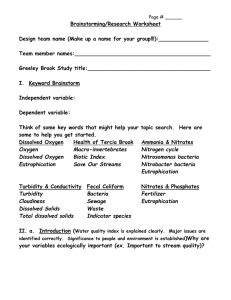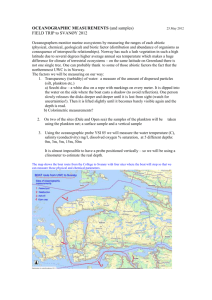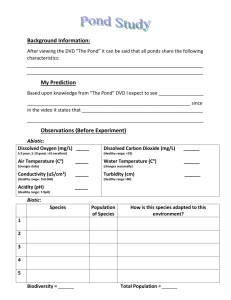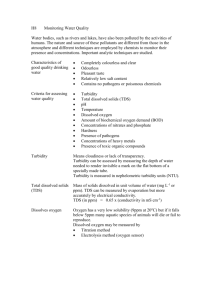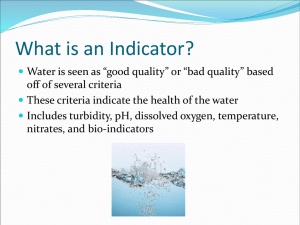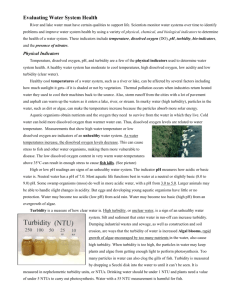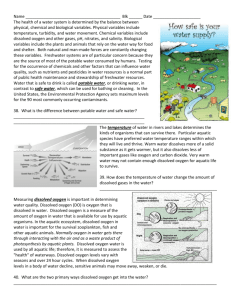Lab: Plankton Sampling and Analysis
advertisement
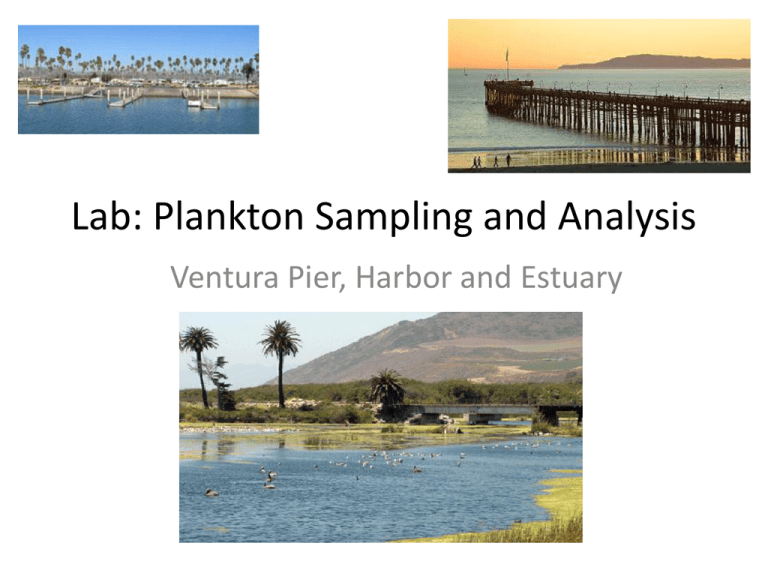
Lab: Plankton Sampling and Analysis Ventura Pier, Harbor and Estuary Objective: Sample water at each location to compare abiotic differences in the water to the plankton distribution. Methods: Use a plankton net to concentrate organisms for comparison at each location. Analyze water samples at each location to find pH, dissolved oxygen, phosphate levels, nitrate levels, temperature and turbidity. Ventura River Estuary “ The fine sediments that enter the river and ocean linger for months, and this is why the water at Surfers' Point often appears muddy, long after the rains have stopped.” (http://www.venturariver.org/search/la bel/watershed) Abiotic Factor: Dissolved Oxygen Oxygen is essential for cellular respiration in most organisms. In an aquatic environment, oxygen availability is influenced by a variety of chemical and physical factors. Some of the factors that affect the amount of oxygen dissolved in water are: •Temperature: As water becomes warmer, its ability to hold oxygen decreases. •Photosynthetic activity: In bright light, aquatic plants are able to produce more oxygen. •Decomposition activity: As organic material decays, microbial processes consume oxygen. •Mixing and turbulence: Wave action, waterfalls, and rapids all aerate water and increase the oxygen concentration. •Salinity: As water becomes more salty, its ability to hold oxygen decreases. Watch the following video clips from the University of Florida and answer: 1. What reduces dissolved oxygen in water? 2. What increases dissolved oxygen in water? 3. What effect does it have on fish? 4. How does temperature affect oxygen levels? http://plants.ifas.ufl.edu/manage/videos# FactorsThatDecreaseDissolvedOxygenInW ater Abiotic Factors: Nitrates and Phosphate Levels • Nitrates and phosphates are nutrition for plants and algae. Do You Remember the Nitrogen Cycle? • As nitrates increase, they act as a plant nutrient and cause an increase in plant growth. As the plant material dies and decomposes, dissolved oxygen levels decrease. • As decomposition of plant and animal material occurs, dissolved oxygen levels decrease and nitrate levels increase. http://www.ncsu.edu/sciencejunction/ depot/experiments/water/lessons/np/ Abiotic Factor: pH Level • Average pH of ocean water is 8 (slightly basic) • An increase in carbon dioxide (CO2) can cause ocean acidification • There is a decrease in the ability of the calcifying phytoplankton to produce calcium carbonate in more acidic waters Electron microscopy photographs of the calcifying phytoplankton Gephyrocapsa oceanica under CO2 conditions of today (top) and under the high CO2 conditions expected by the end of this century (below). • If ocean acidification leads to disturbances in the populations of these organisms, other non-calcifying organisms may out-compete them for food and nutrients, leading to a change in the ecosystem composition of the system. http://www.ocean-acidification.net/FAQeco.html#HowEco Abiotic Factor: Turbidity Turbidity is a measure of water clarity: how much the material suspended in water decreases the passage of light through the water. • Suspended materials include soil particles (clay, silt, and sand), algae, plankton, microbes, and other substances Higher turbidity increases water temperatures because suspended particles absorb more heat. This, in turn, reduces the concentration of dissolved oxygen (DO) because warm water holds less dissolved O2 than cold. Higher turbidity also reduces the amount of light penetrating the water, which reduces photosynthesis and the production of dissolved O2 Suspended materials can clog fish gills, reducing resistance to disease in fish, lowering growth rates, and affecting egg and larval development. Measuring Turbidity Affects of Turbidity on Aquatic Ecosystems Based on what you learned, fill out the chart in your science notebook: Abiotic Factor: Phosphates Nitrates Dissolves Oxygen (O2) pH Level Turbidity Temperature Definition: How it Affects Plankton Growth: Abiotic Factor Definition: How it Affects Plankton Growth: Phosphates Chemical in water that can act as a fertilizer Causes algae to grow rapidly Nitrates Chemical in water that can act as a fertilizer Causes algae to grow rapidly Dissolves Oxygen (O2) Amount of available oxygen in water Cellular respiration (zooplankton)/ Photosynthesis (phytoplankton) pH Level Acidity or alkalinity in water (H+ or OH-) Increased acidity decreases calcifying phytoplankton (makes their shells weak) Turbidity a measure of how much the material suspended in water decreases the passage of light through the water. • Measurement of energy as heat in water Reduces the concentration of dissolved oxygen (DO) because warm water holds less dissolved O2 than cold. Temperature • Higher turbidity increases water temperatures Decreases dissolved O2 and light for photosynthesis
